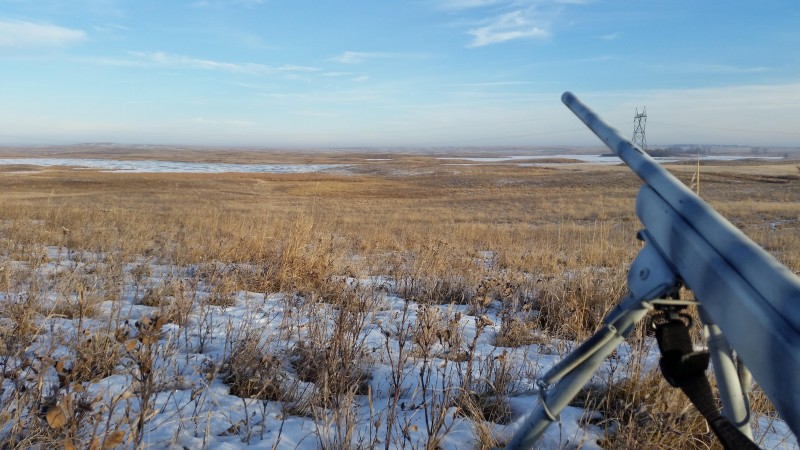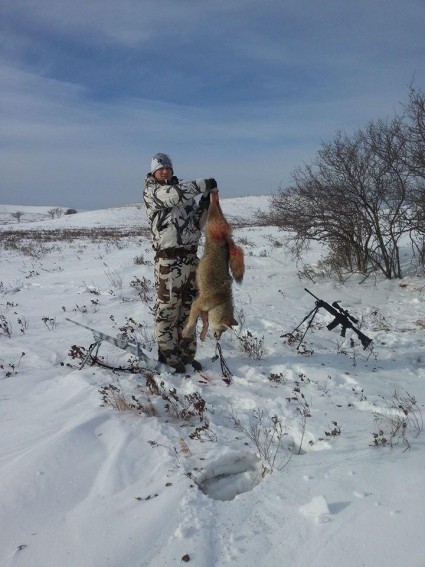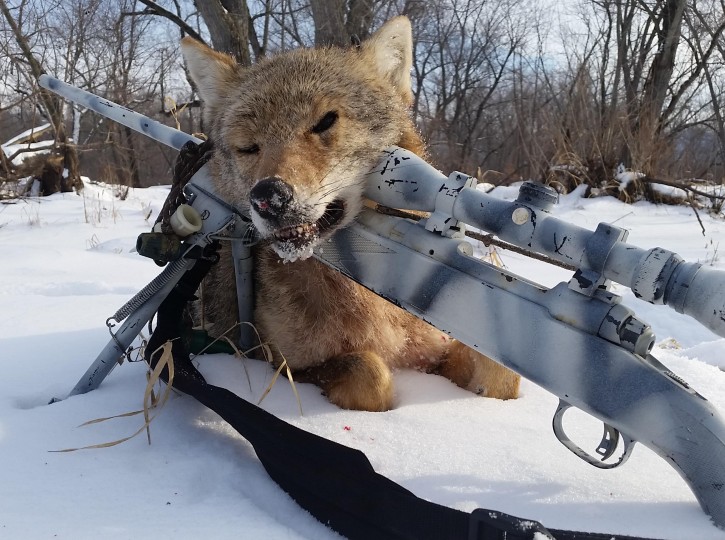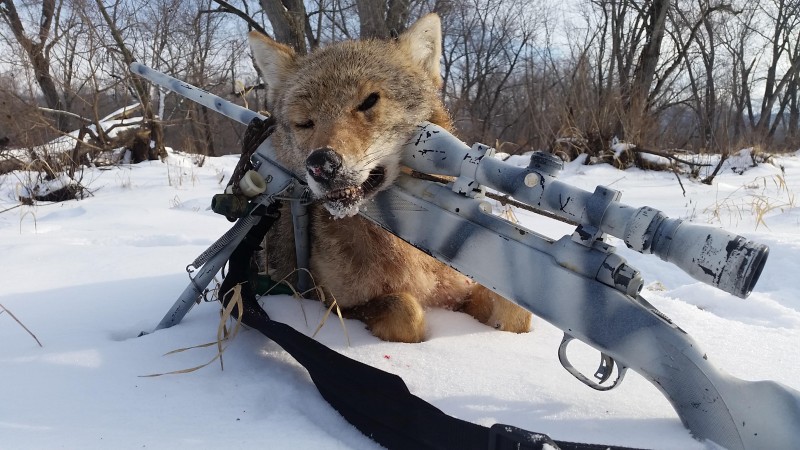Jason Beaulieu
Every year about the time our bow season is under wraps and the snow begins to accumulate as fast as the mercury drops, my mind begins to shift to one thing; calling in coyotes. Starting from about the time I could drive one sport has consumed myself almost more than anything; being able to trick Ol’ Wile E Coyote himself. From frozen sub zero days to bright crisp moonlit nights, it’s the drive to get that adrenaline rush of a coyote charging the caller or feeling that hair raising howl breaking through the silence of the night. If there is anything to learn from coyotes it is that they will make you humble and earn every reward given either by mistakes or shear luck.
One of the biggest challenges to successfully call in coyotes is to always learn from your mistakes. It’s going to happen! But being able to recognize and correct the mistakes will greatly improve your ability to put more fur on the ground. The first step as to any pursuit of an animal is to be where they are. Yes that is very basic but a coyotes home range is typically much greater than that buck we chased during the fall, one or two coyotes cruising overnight can make a roadway look as if a whole herd is going in and out of a certain block of timber.
Location

Gaining access to land to hunt is undoubtedly one of the most important factors when calling. This is something I can say had slowed my progress in being successful when I first started by being too shy and not knocking on doors. Now in my mind, there is no better set than an area that has not been pressured by myself or other hunters. The first step in locating an area I want to hunt is about as simple as it sounds, driving and looking for tracks. Whether it is after a fresh snow or after a windy day you can determine what routes or funnels coyotes in your area like to run. Typical high traffic routes I look for consist of fence lines that run from a large tract of woods to another or a creek running from low bottom brush pocket to another. From there it’s narrowing down a particular square or block of woods that I believe a coyote has a reasonable amount of cover to hide out or hunt in. Scouting for fresh tracks crossing a road or field after a new snow and determining that particular animal hasn’t continued through is best-case scenario. You know that animal is going to be within earshot of your calls on that particular sit. From there you can begin a baseline for particular calling sequences that do and don’t work for you or your area.
Field Setup
After determining an area I want to hunt it’s time to break down how to access the area undetected. If at all possible I try to stay away from walking directly at the “sunny side” of wood patches or areas I think a coyote could be in during early morning setups. The reasoning behind my approach is a coyote will tend to lie on the edge in the warmth of the sun, couple that with a brisk west wind and you could about guarantee they will be laying on the east or south facing side of any terrain. If available use the terrain to conceal yourself walking into your setup, a fence line or tree line to follow can help you access your spot without spooking any possible coyote in the immediate area. When trying to determine how to play the wind I always prefer a crosswind, I usually like to get the greatest downwind view I can and position my body to be able to swing that direction. Not that it will happen every time but if majority rules and the coyote were to come into a field it will almost always want to swing downwind of where it believes the sound is coming from.
Being able to position an electronic caller away and upwind from you can really help connect with that down-wind drifter that doesn’t want to completely commit to running directly at you. This is where I really like to use a fence line on my downwind side to help guide the coyote to me. I cannot honestly say if it helps a particular dog’s confidence or if it’s the simple meaning of following some form of landscape into open spaces that this works but it has become a consistent pattern that I try to exploit when possible.  Setting up below the skyline and in some form of cover will also help get a coyote to close the distance creating an effective shot opportunity. This is something I still struggle with, not every field is setup with brush or old farm machinery to hide in. Just this year I disregarded this thought and setup in what seemed to be tall enough grass to conceal my partner and I until a coyote hit the edge of the field and within seconds decided something was up and turned back into the thicket. It was after a short chat with my partner that I walked across the field and looked back to see the very obvious blob sitting in what looked like the middle of the field. One of those mistakes I have knowingly made before and it ultimately cost an opportunity.
Setting up below the skyline and in some form of cover will also help get a coyote to close the distance creating an effective shot opportunity. This is something I still struggle with, not every field is setup with brush or old farm machinery to hide in. Just this year I disregarded this thought and setup in what seemed to be tall enough grass to conceal my partner and I until a coyote hit the edge of the field and within seconds decided something was up and turned back into the thicket. It was after a short chat with my partner that I walked across the field and looked back to see the very obvious blob sitting in what looked like the middle of the field. One of those mistakes I have knowingly made before and it ultimately cost an opportunity.
Calling Sequence
This is one aspect of calling that you can never research and find the same answer or a proven mix of perfection. There are seemingly too many variables to determine the “perfect” sequence or calling routine that works to draw in coyotes. But there are some key elements that help turn the odds in your favor of drawing one out into the open. Time of the year plays a major role in this, whether it is in the nearing weeks when the coyotes begin their yearly “rut” and howling is almost a must or when the winter is drawing to a close and the vast majority of the dogs you have been chasing have already heard the best rabbit distress scenario play out multiple times. I typically like to do a mix of both during each set throughout the entire season. I will usually start out with a series of non-threatening howls, consisting of high-pitched long drawn out howls. For these I will use about any variation of an open reed call or the old trusty turkey diaphragm. Again whether it has to do with confidence in hearing a coyote in the area or striking the right cord with a grumpy male, in the past few seasons beginning with a series of howls has made a positive impact on the amount of coyotes I have called in. After the first series of howls I will wait 3 to 5 minutes then continue into distress sounds. Like before you can use any variation of open reed hand call, closed reed, diaphragm or E-caller to replicate the sounds of an injured animal. I tend to keep my distress sequences fast paced, short, and frequent, calling roughly 30 seconds and only waiting 1-2 minutes before letting more squeals go. If it’s an area I have previously called I will usually change the pitch of the call or choose a different sounding distress than what I have previously used. Typically I will call an area anywhere from 20 to 40 minutes, depending on how far I think my sounds are reaching, again this is one of those general guidelines I try to follow, sometimes it can take two minutes sometimes its almost a half hour for one to show itself.
During peak breeding time, which in our neck of the woods will kick into full force by mid February into March, I will focus my calling to mostly howls. This is a technique that took me a few seasons to really pin down on exactly how to howl and most importantly how I needed to respond back to a particular response. As a quick break down, barks and short howls mixed in will always weigh towards being aggressive or territorial whereas high pitched long drawn out howls are more neutral and can sound more inviting. With todays E-caller advancements the learning curve is drastically cut down and much easier to consistently replicate the type of howl you want to imitate. Hand calls can give you the ability to put more emotion into your sounds, add a touch more realism, with the capability to respond or mimic a coyote howling back to you rather than having to replay a recorded sound over and over. Both work great and each has their own positives and drawbacks when attempting to convince a coyote you are just another friend or enemy on the block.
Darkness
 Everything changes once darkness falls. These are some of the most heart pounding and hair-raising experiences I have ever encountered in the woods. At this time coyotes are generally “on the move” seeking either a companion or food, when their activity level is peaked. This is where your scouting can really help your odds. Those travel routes that you found during the day are now in use and it is very safe to say that they will not only be in those thickets or woodlots but also out cruising between sections of timber and areas of cover. Although (where legal) a spotlight can come in handy when the moon is either less than full or cloudy, any moon over ¾ full will give you enough light to scan across a snow covered field. There is nothing like catching a glimpse of a floating shadow crossing a white blanket of snow. Not that coyotes completely let their guard down but are seemingly more responsive and less elusive in the darkness. I will hunt the same style of setups as I do during the daylight. Most of the time this is when you can rely on your howling to locate and convince a coyote to come to you.
Everything changes once darkness falls. These are some of the most heart pounding and hair-raising experiences I have ever encountered in the woods. At this time coyotes are generally “on the move” seeking either a companion or food, when their activity level is peaked. This is where your scouting can really help your odds. Those travel routes that you found during the day are now in use and it is very safe to say that they will not only be in those thickets or woodlots but also out cruising between sections of timber and areas of cover. Although (where legal) a spotlight can come in handy when the moon is either less than full or cloudy, any moon over ¾ full will give you enough light to scan across a snow covered field. There is nothing like catching a glimpse of a floating shadow crossing a white blanket of snow. Not that coyotes completely let their guard down but are seemingly more responsive and less elusive in the darkness. I will hunt the same style of setups as I do during the daylight. Most of the time this is when you can rely on your howling to locate and convince a coyote to come to you.
Good luck to those of you in the snow and on the ice this season, remember being on the ice is not the only way to get a thrill out of winter!

